Mexico Journal: 11 Abril 06
Sunday we took a four-hour bus trip from Puebla to Veracruz. Much of it was through a gorgeous mountain pass. We could see very little at the top because we were in the low-hanging clouds. The glimpses we did see, though, were stunning. Looked like the million shades of green you see in parts of Oregon.
Once we arrived in Veracruz we learned two quick lessons:
1. Always ask a price before getting into a cab.
We hopped a cab from the bus station to the zocalo. We hung on for dear life as the cabbie sped through the streets, honking almost endlessly, weaving in and out of traffic and actually reaching out to slap another car so he could pass it as three lanes merged to two. It worked.
When we got stuck in traffic and regained the ability to speak, we asked what the fare would be. He said, "$100 pesos." Amy answered, "$100 pesos!?!?" I, wanting to get out of the car in one piece, gave her a don't-mess-with-this-cabbie look. Even my dad, who drives like a cross between Richard Petty and Evil Knievel, would have been white-knuckling this ride.
We paid the $100 pesos (about 10 bucks) and staggered on our way. We later learned the ride should have cost about $30 pesos. Bastard.
Veracruz is very colorful -- the buildings, the people, the music. We got there about 9 p.m. on Palm Sunday and the zocalo was packed. Dancers were performing and vendors had carts set up. All the restaurants were packed. We soon learned this was normal. The zocalo was bustling with people and music every night until 4 a.m.
2. Ask to see a hotel room before booking it.
Tired and hungry, eager to drop our bags, we went to straight to the Hotel Imperial (now forever known to us as Hotel Inferior) on the zocalo. The lobby was beautiful. The rooms, however, were pitiful and gross. The second we opened the room's door the smell of mildew overwhelmed us. The bathroom ceiling tiles were all out of whack, offering nice views of the crawl space between floors and exposed wiring.
We had paid first, though, foolishly. After deciding we wouldn't stay there, we had to figure out how to explain that to the woman at the front desk and try to get our money back. The clerk called her "jefe" to tell him "dos Americanos" (clearly said with great disdain) wanted a refund. Eventually, after she seemed to be on the verge of tears, she gave us $500 pesos in cash.
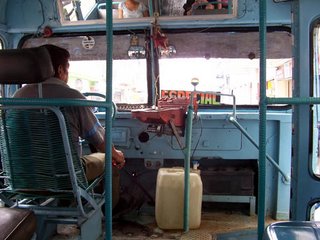 We took city buses whenever possible. They're a far cry from Portland's beloved TriMet offerings, but there's no better way to see a city than from the interior of a former school bus that was probably totaled in Ohio, shipped out of the country and rebuilt in Mexico with sheet metal welded to the floor to cover rusted out holes. Airbags? Seatbelts? Padded chairbacks? Ha! Hang a crucifix on the mirror, cross yourself when you pass a church and hang on for the ride, baby. Look at the driver's headrest in this particular bus. It's one of the many customized touches you'd see. Often women's names (mothers, wives and daughters, I presume) adorned the display space over the drivers' heads. Pay about three pesos and, I swear, I think you could ride all day.
We took city buses whenever possible. They're a far cry from Portland's beloved TriMet offerings, but there's no better way to see a city than from the interior of a former school bus that was probably totaled in Ohio, shipped out of the country and rebuilt in Mexico with sheet metal welded to the floor to cover rusted out holes. Airbags? Seatbelts? Padded chairbacks? Ha! Hang a crucifix on the mirror, cross yourself when you pass a church and hang on for the ride, baby. Look at the driver's headrest in this particular bus. It's one of the many customized touches you'd see. Often women's names (mothers, wives and daughters, I presume) adorned the display space over the drivers' heads. Pay about three pesos and, I swear, I think you could ride all day.We got settled in a better hotel and headed to dinner about 10 p.m.
Veracruz is a tourist town where Mexicans vacation. We saw lots of tourists, but hardly any Americans. For the most part, the people were pleasant, but as in any tourist town, always looking to get just a little more out of you.
There is an interesting contrast in watching the wealthy Mexican families on vacation interact with the poorer people selling crafts table-to-table at the restaurants. One of the travel books called Veracruz "Mexico in miniature." This holds true -- people seemed mostly rich or poor, not much of a middle class.
Veracruz is a port town. The area near the port has lots of market vendors and hotels, however, the port itself is no tourist draw. The water around it is extremely polluted.
One day during our stay in Veracruz, we walked a few miles south of the port until we found the nice beaches overlooking the Gulf of Mexico. People lounged at tarp-covered tables and drank while children played in the surf. Pick-up games of soccer and volleyball played out up and down the sand. People just strolled everywhere.
Most nights we ate dinner on the zocalo, listening to music and people watching late into the evening.
Amy's foodie report:
Caldron de camarones: A large clay bowl filled with a spicy, red broth and about 10 of the largest shrimp imaginable. The entire shrimp -- head and all -- is in there. You pick apart the critters, put the meat back in the broth and dig in to all that delicious flavoring that's been released by cooking the whole shrimp in the juice. Messy, but well worth the trouble.
Cacahuates: Restaurants near the zocalo don't serve appetizers. Street vendors walk table-to-table, selling roasted and salted peanuts. Yum. Some pistacios and pumpkin seeds, too.
Queso: Other vendors come by selling balls of white cheese about the size of golf balls. They dice it up at your table and top it with onions and veggies.
Street vendors also sell lots of fruit. They have a beautiful way of slicing a mango so that it resembles a flower. Served on a stick.
Other scenes from Veracruz:
Our city bus driver (like the earlier bus picture, but a different bus), hauling-ass down a main drag. Flashed past the police station in at least fourth, but maybe fifth, gear. And promptly got pulled over a few blocks later with us sitting in the back wondering what's going to happen. He hopped out and ran back to talk to the cop and quickly returned to drive us on our way. Do that in the States and you're likely to get shot by the police.
The shocker guy: On the zocalo, enterprising men and women will find amazing ways to make a buck. The most shocking was a guy who walked table-to-table with a small camping-style battery hanging from his neck and two cables with nice chrome handles extending from it. Pay him -- I'm sorry I didn't ask how much -- for the pleasure of being shocked. And, yes, people really did pay. Popular at the bars late at night. Even with families.
Blood-pressure lady: Woman in white nurse's smock offered to take your blood pressure during meals. Why she and shocker guy didn't get together, I don't know. Great marketing potential.
Also for sale on the zocalo at your table as you eat:
- Balloons
- Watches -- "ROLEX!"
- Bootleg DVDs and CDs
- Shirts
- Belts
- Shoeshines
- Newspapers and magazines
- Cheese
- Baby dolls
- Jewelry
- Lottery tickets (not for gringos, best we could tell)
- Bread
- Dulces
- Gum
- Cigarettes and cigars
- Songs for your sweetheart, from the endless bands
- Caricatures
- Other knick-knacks
There's a clear protocol between waiters, vendors and musicians on the zocalo. Waiters always take precedence. Musicians get second dibs. Street vendors bring up the rear, always getting out of the way of the others.
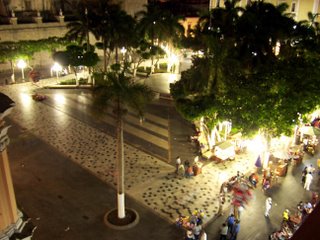 The zocalo at night.
The zocalo at night.The guys in uniform managing traffic at an intersection near our morning coffee shop did -- or didn't do -- their job based on who needed to cross the street.
Blondes such as Amy: I'll step in front of a bus for you, ma'am.
Latinos: OK, OK. Hang on. I'm coming.
Indigenous: Hello? Cross on your own, pal. Implied through their being completely ignored.
There's also a weird shoe fetish going on in Veracruz. Tons of shoe stores. Many shoe shine places. And people kept checking out my $60 black-and-orange Nikes. Nice or crappy, shined or scuffed, the footwear seemed to say a lot about the people wearing them. And what people think of the people wearing them.

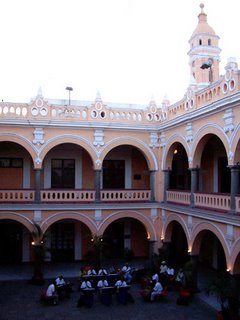
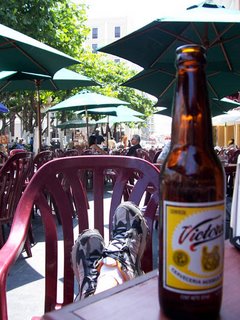
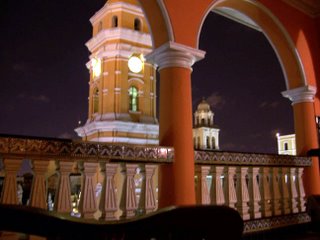
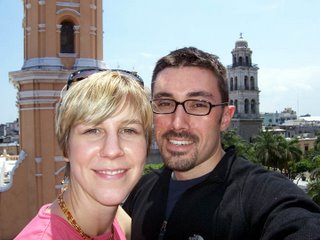
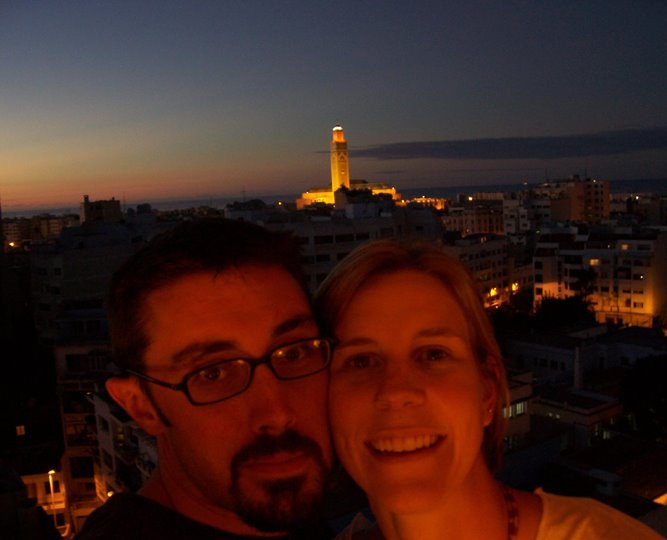



No comments:
Post a Comment